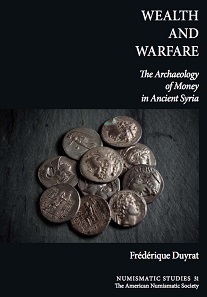by Ursula Kampmann
translated by Annika Backe
June 15, 2017 – With ‘Wealth and Warfare – The Archaeology of Money in Ancient Syria’ in the Numismatic Studies series of the American Numismatic Society, Frédérique Duyrat presents a detailed monograph that is much more than a mere list of hoards and their systematic analysis of both coin circulation and chronology. As she points out in her foreword, the aim of her work is “to establish the limits of what we can learn from coin circulation, to compare the data from commerce to the data from legal excavations, to try to understand the chronological evolution of coin circulation and how much political events or warfare affect it, to evaluate what coin finds tell us of the wealth and poverty of the people who collected them”.
Frédérique Duyrat, Wealth and Warfare. The Archaeology of Money in Ancient Syria. Numismatic Studies 34. The American Numismatic Society, New York 2016. 596 pages, b/w figures and tables, 28.8 x 22.6 cm. Hardcover. ISBN: 978-0-89722-346-1. $200 plus postage ($140 plus postage for ANS members).
Thus the book focuses on the great number of hoards discovered in Syria in the past. To Duyrat, Syria isn’t just today’s nation but the entire area known as Syria in ancient times. But of course no one dealing with Syria can evade the issue of how and to which extent the coins currently available on the market stem from old hoards or, rather, came to the West in the days of ISIL. When the author submitted her monograph at the Sorbonne, the dream of the Arab Spring started in Tunisia that was to find an end in the nightmare of the Syrian civil war. Duyrat of course quotes all the ghastly news on the trade in antiquities funding terror. Unfortunately, at the time writing her book she didn’t have the qualifying results recent studies on this topic have brought.
Let’s have a look at the structure of the book first. As the basis of the work, Frédérique Duyrat assembles an impressive 360 hoards. The coins treated are not illustrated even if they haven’t been published elsewhere. Stated are the find spot (if known), the date the hoard was presumably buried, a list of its content, bibliography, and further remarks. Adding to the hoards, the coins that have been found in 58 state excavations are presented, arranged according to the same principle.
Next is the analysis. Here, the author first of all deals with chronological problems, the typology of the hoards and, most of all, the reconstruction of lost hoards that have been preserved as well as scattered through being traded. In this chapter, she collects a wealth of evidence of how the rural population has found and looked for hoards since the 19th century; and how they sold them to a middleman who has not melted them down for their metal value but brought them to markets in the West instead. And she clearly shows how the new regulation hasn’t put an end to the hoards disappearing but resulted in the loss of information that used to came with every hoard. She gives a vivid account of the behavior of a (contemporary) Tripoli-based collector who showed her a hoard from Northern Syria a farmer had found in his backyard (and smuggled across the border). The collector firmly insisted to remain unnamed and revealed the coins’ exact find spot only reluctantly. In view of legal implications, the find could not have been included in the catalog which surely is a loss for science.
What follows are the analyses expected from such a publication, arranged according to the content of the finds:
- Before Alexander
- Alexander and the Successors (333-280)
- The Two Syrias
- From Kings to Cities
Two closing chapters summarize the general findings on the containers of the coin finds and the ones who hid them, on the use of coins and monetarization.
A comprehensive bibliography, 37(!) maps and an index makes the weighty volume more accessible.
In her book Frédérique Duyrat shows that a present-day numismatist can no longer ignore the fact that his work isn’t just noble science but is embedded in a socio-political context where the people and the state fight over the issue of who is entitled to handle the legacy of the past. Therefore, she presents not just a scientific analysis of the hoards but takes on the issue of how to deal with the situation.
Scientifically-thinking person that she is, she puts findings first, which becomes at least apparent in the inconspicuous sentence: “The importance of material coming from excavations, whether legal or not, no longer needs to be demonstrated.” The value of a coin for the general public first and foremost lies in its scientific message. The question of who owns it is of secondary importance.
Nevertheless, the reviewer takes the liberty of adopting a different view than Duyrat when she writes “with the hope that the Syrian Cultural heritage will be returned to its people one day”. One could equally hope that one day the countless coins might be there to see not only in Syria but throughout the world, and that those concerned with these coins will begin to feel closer to the Syrian nation than we are witnessing it happen today.
Europeans can order the book via Oxbow.
For customers from the US, it should be simpler to buy the book in the ANS Store.





